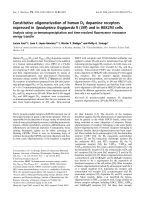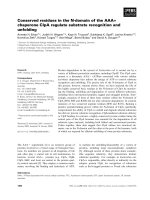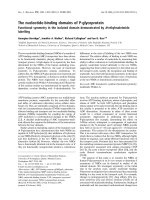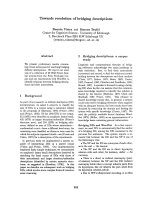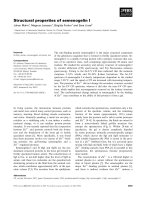báo cáo khoa học: " Primary choriocarcinoma of the renal pelvis presenting as intracerebral hemorrhage: a case report and review of the literature" docx
Bạn đang xem bản rút gọn của tài liệu. Xem và tải ngay bản đầy đủ của tài liệu tại đây (1.38 MB, 4 trang )
CASE REP O R T Open Access
Primary choriocarcinoma of the renal pelvis
presenting as intracerebral hemorrhage: a case
report and review of the literature
Fani Kyriakou
1*
, Michael M Vaslamatzis
2
, Styliani Bastani
1
, Maria Alexandra Lianou
3
, Christina Vourlakou
3
and
Antonia Koutsoukou
1
Abstract
Introduction: A choriocarcinoma is a malignant neopl asm normally arising in the gestational trophoblast, gonads
and, less frequently, the retroperitoneum, mediastinum and pineal gland. Primary choriocarcinomas of the renal
pelvis are extremely rare.
Case presentation: We report a case of primary choriocarcinoma of the renal pelvis in a 38-year-old Greek woman
of reproductive age, presenting with a sudden development of intracerebral hemorrhage due to metastatic lesions.
The diagnosis was established with a renal biopsy, along with an elevated serum level of beta-human chorionic
gonadotropin. An extensive diagnostic work up confirmed the origin of the choriocarcinoma to be the renal pelvis.
Conclusion: Extragonadal choriocarcin omas are rare neoplasms that require extensive laboratory and imaging
studies to exclude a gonadal origin. Moreover, this is the first case of severe intracerebral hemorrhage as the initial
presentation of primary choriocarcinoma of the renal pelvis. Nonetheless, choriocarcinomas should be considered
in the differential diagnosis of women of reproductive age.
Introduction
A choriocarcinoma is a malignant neoplasm normally aris-
ing in the gestational trophoblast and gonads. Choriocarci-
nomas of the renal pelvis are extremely rare and they often
present in association with transitional cell carcinoma
(TCC). Their presenting symptoms are flank pain and
macrohematuria. We present a case of primary choriocar-
cinoma of the renal pelvis in a woman of reproductive age
presenting with sudden development of intracerebral
hemorrhage.
Case presentation
A 38-year-old Greek woman was transferred to the
Emergency Department of our hospital in a comatose
state. After intubation, an urgent computed tomography
(CT) scan of her brain was performed, which revealed a
7.8 × 3.3 × 5.0 cm intracerebral hematoma located at her
left occipitoparietal area with surrounding edema and a
midline shift.
Our patient had a history of two pregnancies that
were normal t erm Cesarean deliv eries, the first four
years ago and the second 10 months ago. The rest of
her medical history was unremarkable.
An emergent craniotomy was performed along with
evacuation of the hematoma. After surgery, she was
transferred to the Intensive Care Unit (ICU). Our patient
remained sedated and mechanically ventilated for neuro-
protection, while an intraparenchymal monitoring device
was inserted for continuous monitoring of her intracra-
nial pressure. Intracranial hypertension was treated with
osmotic diuretics, hyperventilatio n and hypertensive
therapy, aiming to maintain a constant cerebral perfusion
pressure higher than 60 mmHg.
A laboratory workup, including liver and renal function
tests, coagulation screening, fibrinogen and fu ll blood
count, were normal. Due to the enlargement of the right
hilus found on a chest X-ray, extensive CT imaging studies
were performed, which revealed a space occupying lesion
attheinferiorpoleofherrightkidney(approximately
* Correspondence:
1
1st Critical Care Department and Pulmonary Services, Evangelismos General
Hospital, University of Athens Medical School, Ipsilantou 45-47, 10676
Athens, Greece
Full list of author information is available at the end of the article
Kyriakou et al. Journal of Medical Case Reports 2011, 5:501
/>JOURNAL OF MEDICAL
CASE REPORTS
© 2011 Kyriakou et al; licensee BioMed Central Ltd. This is an Open Access arti cle distribu ted under the terms of the Creative
Commons Attribution License ( which permits unrest ricted use, distribution, and
reprodu ction in any medium, provided the original work is properly cit ed.
3 cm), a solitary nodule at the IVa part of her liver consis-
tent with a metastatic lesion, a soft tissue mass situated in
the right hilus of her lung enhanced by intravenous con-
trast and diffusely distributed chest nodules without
intrathoracic lymph nodes.
Her serum level of b-chorionic gonadotropin (b-hCG)
was over 200,000 mIU/mL a nd t his value was repeatedly
confirmed. Nonetheless, a pelvic examination was unre-
markable and all the imaging studies (pelvic ultrasonogra-
phy, including transvaginal ultrasonography and pelvic
CT) revealed the normal appearance of her uterus and
bilateral ovaries.
During the next two weeks, our patien t dem onstrated
gradual improvement of her general status and she was
able to open her eyes spontaneously.
Magnetic resonance imaging of her brain showed, apart
from postsurgical lesions at the area of the hematoma, a
metastatic lesion situated on her left temporal lobe,
whereas a magnetic angiography did not reveal any
vascular dysplasia.
On the 26
th
day of her ICU stay, our patient underwent
an ultrasound guided fine needle aspiration of the hepatic
lesion in order to establish a histological diagnosis for pos-
sible further treatment. Due to consequent intra-abdom-
inal bleeding, she was given surgical radiofrequency
ablation of the hepatic lesion. A right nephrectomy was
also performed due to the size of the lesion with evidence
of imminent bleeding.
On the 35
th
day she had a new episode of massive
intracerebral hemorrhage, confirmed by CT, which was
considered inoperable by our neurosurgeons. She died
10 days later, due to septic shock.
Macroscopic examination following the right nephrect-
omy revealed the presence of a grey-re d tan encapsulated
tumor, which measured 6 × 3.5 × 3 cm, situated at the
inferior pole, invading the renal pelvis-pelvicalyceal system
and extending to the renal capsule. The histological exam-
ination of this mass showed the presence of a malignant
neoplasm composed of syncytiotrophoblastic and cytotro-
phoblastic cells in an extensively hemorrhagic and necrotic
background with subsequent cystic degeneration and
numerous neoplasmatic vascular emboli (Figures 1 and 2).
Immunohistochemical staining revealed intense expression
of b-hCG (Figure 1) and placental alkaline phosphatase,
although it was negative for epithelial membrane antigen
(EMA) and thyroid transcription factor-1 (TTF-1) expres-
sion. All above findings are indicative of a choriocarci-
noma of the renal pelvis. The hepatic biopsy revealed
neoplastic invasion of the liver by a tumor histologically
identical to the choriocarcinoma of her renal pelvis.
Discussion
Choriocarcinoma is a rare malignant tumor of genital
cells that develops usually in the uterus, th e ovaries or
the placenta of women after molar or, rarely, after nor-
mal gestation and in the testis of men. Choriocarcino-
mas disseminate rapidly through the hematogenous
route; the lungs, brain and liver are the distant organs
more often involved [1].
Extragonadal choriocarcinomas are scarce neoplasms.
They have been described in isolated cases, located in
the gastrointestinal system, the lungs, the urinary blad-
der and the pineal gland [2,3].
Figure 1 Right kidney ( renal pelvis-pelvicalyceal system).
Intense (+++) immunohistochemical staining for b-HCG
(magnification × 400).
Figure 2 Right kidney ( renal pelvis-pelvicalyceal system).
Intense presence of syncytiotrophoblasts and trophoblasts in a
carcinomatous area (hematoxylin and eosin stain; magnification ×
200).
Kyriakou et al. Journal of Medical Case Reports 2011, 5:501
/>Page 2 of 4
Primary choriocarcinoma of the renal pelvis, as
described in this case report, is extremely rare. Slightly
more frequent, although rare too, are choriocarci nomas
in association with high grade TCC. The cases described
in the international literature are very few and their
characteristics are highlighted in Table 1.
Campo et al. detected the presence of hCG-immunor-
eactive cells in nine (19%) out of 47 patients with high
grade urothelial carcinoma. In only one of those cases
was the neoplasm situated in the renal pelvis and the
54-year-old patient had been treated with nephrectomy.
Histological examination of this tumor revealed a transi-
tional cell carcinoma with choriocarcinomatous ele-
ments [4]. Grammatico et al. described the case of a
TCC with choriocarcinomatous different iation involving
the pelvoureteric junction of the kidney in an 84-year-
old man with hematuria [2]. Vahlensieck et al. reported
b-hCG-positive extragonadal germ cell neoplasia of the
renal pelvis in a 56-year-old woman with a history of
flank pain on the right side for three yea rs [5]. Huang et
al. described the case of a choriocarcinoma of the right
kidney in a man presenting with fever, gross hematuria
and flank pain [6]. In all above mentioned cases, preo-
perative serum levels of b-hCG are not available, while
it is not mentioned if there were metastases. Hara et al.
presented the case of a 68-year-old man with hematuri a
diagnosed with a high grade TCC with choriocarcino-
matous component of his left renal pelvis [3]. More
recently, Zettl et al. reported the case of a tumor of the
renal pelvis composed of papillary urothelial carcinoma
in association with choriocarcinoma, in a 60-year-old
male patient presenting with painless macrohematuria.
Chromosomal analysis revealed a close genetic relation-
ship between these two carcinomatous components.
This led the authors to suggest that the choriocarci-
noma may have resulted from c lonal evolution of the
urothelia l carcinoma. As in our case, widespr ead hepatic
and pulmonary metastases were found in this patient,
while the b-hCG levels in his serum were elevated [7].
According to the predominant theories, extragonadal
choriocarcinomas arise from multipotent cells left
behind during early embryologic development, from
dedifferentiation of neoplastic urothelial transitional
cells, or from a metaplastic procedure [2].
Pathologically, the tumor s have been described a s
large and exophytic, often showing hemorrhage and
necrosis. In all cases, the presence of choriocarcinoma
was indicated by the presence of syncytiotrophoblastic
elements. In accordance with previous studies, we
observed giant syncytiotrophoblasts with intense
b-hCG and placental alkaline phosphatase positive
reactivity, while extensive necrosis was a predominant
feature.
The differential diagnosis between choriocarcinomas
of the urothelial system and mixed choriocarcinomas
associated with TCC, on histological grounds, is very
difficult and it is bas ed on stro ng expression o f b-hCG.
Moreover, EMA is positive for TCC but negative for
choriocarcinoma [8].
Extensive clinical and laboratory research is needed in
order for the primary extragonadal localization to be con-
firmed [5]. In the present case, the histological and immu-
nohistochemical characteristics, along with the location of
the disease, the absence of tumor in the gonads, the nega-
tivity of TTF-1 expression by the tumor cells and the
absence of intrathoracic lymph nodes [9] were absolutely
compatible with a de novo choriocarcinoma of the renal
pelvis.
Interestingly, in our case, there was a marked absence
of symptoms from the urothelial system, especially
hematuria, which is in contrast with the international
literature [3]. Severe intracerebral hemorrhage as an
initial presentation of primary choriocarcinoma of the
urothelial system has not been described so far. Intra-
cerebral hemorrhage represents the commonest clinical
appearance of primary choriocarcinomas of the genital
system with cerebral metastasis [10]. The trophoblastic
carcinomas are supplied by fragile vessels and simulta-
neously have the tendency to invade and destroy the
wall of these vessels, thus provoking bleeding. Cerebral
metastases are associated with a worse prognosis.
Since all chorio carcinomas contai n and produce hCG,
serum b-hCG values have bee n used for the diagnosis
and follow up of extragonadal localizations (breast, lung,
Table 1 Summary of the characteristics of reported cases of choriocarcinoma.
Case Reference Age Sex Material Histologic type Serum HCG Tissue HCG Outcome (months)
1 [4] 54 M Kidney TCC-CC ND ++ A6
2 [5] 56 F Kidney CC ND NA A22
3 [6] M Kidney CC NA NA D4
4 [2] 84 M Kidney TCC-CC ND NA NA
5 [3] 68 M Kidney TCC-CC High NA NA
6 [7] 60 M Kidney TCC-CC ND NA D1,5
7 Present 38 F Kidney-Liver CC High +++ D1
A: alive; CC: choriocarcinoma; D: dead; F: female; M: male; NA: not available; ND: not done; TCC: urothelial transitional cell carcinoma.
Kyriakou et al. Journal of Medical Case Reports 2011, 5:501
/>Page 3 of 4
kidney and stomach). Serum values of b-hCG in our
patient were repeatedly over 200,000 mIU/mL.
Extragonadal choriocarcinomas are usually diagnosed
when they have metastasized. The surgical excision pro-
posed by the literature is performed either for localized
disease or for establishing the final diagnosis [3,5,7]. In
our case, the presenting symptoms, the exten t of the di s-
ease, the bad performance status and co-existent infec-
tion prohibited further treatment.
Conclusions
We present the case of a 38-year-old woman with primary
choriocarcinoma of the renal pelvis and severe intracereb-
ral hemorrhage. To the best of our knowledge, this is the
first case of extragonadal choriocarcinoma described that
presented as an intracerebral hemorrhage. Clinicians
should thus be conscious of this atypical clinical presenta-
tion in women of reproductive age.
Consent
Written informed consent was obtained from the
patient’ s next-of-kin for the publication of this case
report and any accompanying images. A copy of the writ-
ten consent is available for review by the Editor-in-Chief
of this journal.
Abbreviations
β-hCG: beta-chorionic gonadotropin; CT: computed tomography; EMA:
epithelial membrane antigen; ICU: intensive care unit; TCC: transitional cell
carcinoma; TTF-1: thyroid transcription factor-1.
Author details
1
1st Critical Care Department and Pulmonary Services, Evangelismos General
Hospital, University of Athens Medical School, Ipsilantou 45-47, 10676
Athens, Greece.
2
Oncology Department, Evangelismos General Hospital,
Ipsilantou 45-47, 10676 Athens, Greece.
3
Pathology Department,
Evangelismos General Hospital, Ipsilantou 45-47, 10676 Athens, Greece.
Authors’ contributions
FK participated in all medical interventions, collected the data and drafted
the manuscript. MMV drafted the final version of the manuscript. SB
participated in all medical interventions and drafted the final version of the
manuscript. MAL participated in the diagnosis. CV participated in the
diagnosis. AK participated in all medical interventions and drafted the final
version of the manuscript. All authors read and approved the final
manuscript.
Competing interests
The authors declare that they have no competing interests.
Received: 20 September 2010 Accepted: 5 October 2011
Published: 5 October 2011
References
1. Wheeler CA, Davis S, Degefu S, Thorneycroft IH, O’Quinn AG: Ovarian
choriocarcinoma: a difficult diagnosis of an unusual tumor and a review
of the hook effect. Obstet Gynecol 1990, 75:547-549.
2. Grammatico D, Grignon DJ, Eberwein P, Shepherd RR, Hearn SA, Walton JC:
Transitional cell carcinoma of the renal pelvis with choriocarcinomatous
differentiation. Immunohistochemical and immunoelectron microscopic
assessment of human chorionic gonadotropin production by transitional
cell carcinoma of the urinary bladder. Cancer 1993, 71:1835-1841.
3. Hara S, Ito K, Nagata H, Tachibana M, Murai M, Hata J: Choriocarcinoma of
the renal pelvis: a case report. Hinyokika Kiyo 2000, 46:117-121.
4. Campo E, Algaba F, Palacin A, Germa R, Sole-Balcells FJ, Cardesa A:
Placental proteins in high-grade urothelial neoplasms. An
immunohistochemical study of human chorionic gonadotropin, human
placental lactogen, and pregnancy-specific beta-1-glycoprotein. Cancer
1989, 63:2497-2504.
5. Vahlensieck W Jr, Riede U, Wimmer B, Ihling C: Beta-human chorionic
gonadotropin-positive extragonadal germ cell neoplasia of the renal
pelvis. Cancer 1991, 67:3146-3149.
6. Huang CH, Chen L, Hsieh HH: Choriocarcinoma presenting as a unilateral
renal mass and gross hematuria in a male: report of a case. J Formos
Med Assoc 1992, 91:922-925.
7. Zettl A, Konrad MA, Polzin S, Ehsan A, Riedmiller H, Müller-Hermelink HK,
Ott G: Urothelial carcinoma of the renal pelvis with choriocarcinomatous
features: genetic evidence of clonal evolution. Hum Pathol 2002,
33:1234-1237.
8. Cho JH, Yu E, Kim KH, Lee I: Primary choriocarcinoma of the urinary
bladder-a case report. J Korean Med Sci 1992, 7:369-372.
9. Jagirdar J: Application of immunohistochemistry to the diagnosis of
primary and metastatic carcinoma to the lung. Arch Pathol Lab Med 2008,
132:384-396.
10. Huang CY, Chen CA, Hsieh CY, Cheng WF: Intracerebral hemorrhage as
initial presentation of gestational choriocarcinoma: a case report and
literature review. Int J Gynecol Cancer 2007, 17:1166-1171.
doi:10.1186/1752-1947-5-501
Cite this article as: Kyriakou et al.: Primary choriocarcinoma of the renal
pelvis presenting as intracerebral hemorrhage: a case report and review
of the literature. Journal of Medical Case Reports 2011 5:501.
Submit your next manuscript to BioMed Central
and take full advantage of:
• Convenient online submission
• Thorough peer review
• No space constraints or color figure charges
• Immediate publication on acceptance
• Inclusion in PubMed, CAS, Scopus and Google Scholar
• Research which is freely available for redistribution
Submit your manuscript at
www.biomedcentral.com/submit
Kyriakou et al. Journal of Medical Case Reports 2011, 5:501
/>Page 4 of 4
